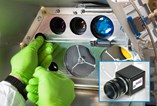Sensors Unlimited's SWIR Cameras On Board Historic LCROSS

Images will help determine presence of water on the moon – Lunar crash slated for Oct.9, 2009
Princeton, NJ - Sensors Unlimited, Inc., part of Goodrich ISR Systems, employees will be eating MoonPies and watching television this Friday morning as they view images resulting from a NASA rocket crashing into the dark side of the moon. The employees design and build the innovative short wave infrared (SWIR) cameras, based on indium gallium arsenide (InGaAs) imaging technology, that will image and analyze the cloud of post-crash debris. The images could prove the presence of water on the moon, a key to future space exploration and understanding of the solar system.
The lunar crash is part of NASA’s Lunar Crater Observation and Sensing Satellite (LCROSS) mission to search for water on the moon. A ‘shepherding spacecraft’ carrying a cadre of sophisticated instruments, including two InGaAS-SWIR cameras, will orbit the moon; at the precise moment, a Centaur rocket will be launched from the spacecraft for an impact at twice the speed of a bullet into a crater near the moon’s south pole. The rocket’s impact will raise a cloud of dust and debris that is expected to contain particles of ice. The SWIR cameras will record images of the debris, which will be transmitted back to Earth in real time for evaluation.
Because the Goodrich SWIR cameras can detect moisture contrast through dust, smoke and fog, they have the unique ability to accurately record the LCROSS crash incident for precise study of the debris cloud. SWIR technology detects reflected light at wavelengths that the human eye cannot see, in wavelength bands between visible and thermal cameras. The extremely small and lightweight size of the Goodrich system makes it ideal for space travel; use of advanced materials and circuitry allow it to run without cooling, unlike other night vision technologies that need cumbersome cooling systems.
“Our 80 employees in Princeton are looking forward to making history with the LCROSS mission,” said Ed Hart, vice president and general manager, Princeton operations, Goodrich ISR Systems. “The SWIR technology provides unmatched capability for numerous applications from fire fighting to homeland security, and we are honored to bring this capability to further mankind’s knowledge of space.”
While the LCROSS mission marks the first time that the Goodrich SWIR camera has made it into space, it came close to making the trip back in 2005 as part of the carry-on gear of a space tourist. Princeton-based entrepreneur Greg Olsen was one of the founders of Sensors Unlimited, Inc. (now part of Goodrich) that developed the small, SWIR sensing technology. In 2005, Olsen traveled with Russian cosmonauts to the International Space Station. He planned on taking along one of the company's small SWIR cameras to image the Earth, seeing through clouds and capturing details of weather formations. But the U.S. government would not allow the SWIR camera to travel to Russia due to International Traffic in Arms Regulations (ITAR), citing its military significance.
Sensors Unlimited, Inc., part of Goodrich ISR Systems, based in Princeton, NJ, has pioneered the design and production of NIR and SWIR cameras and systems utilizing advanced Indium Gallium Arsenide (InGaAs) imaging technology for industrial, commercial, military, agricultural, and scientific markets.
Goodrich Corporation, a Fortune 500 company, is a global supplier of systems and services to aerospace, defense and homeland security markets. With one of the most strategically diversified portfolios of products in the industry, Goodrich serves a global customer base with significant worldwide manufacturing and service facilities.
